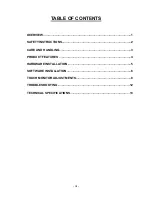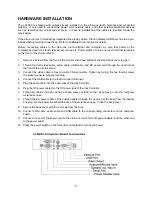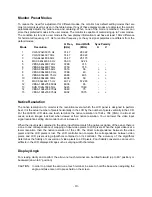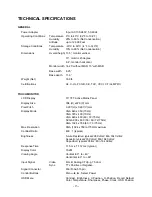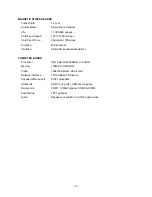
- 10 -
Monitor Preset Modes
To reduce the need for adjustment for different modes, the monitor has default setting modes that are
most commonly used as given in the table below. If any of these display modes are detected, the monitor
automatically adjusts the picture size and centering. When none of the mode is matched, the user can
store their preferred modes in the user modes. The monitor is capable of memorizing up to 7 user modes.
The condition to store as a user mode is the new display information must have at least 1 KHz difference
for horizontal frequency or 1 Hz for vertical frequency or the sync signal polarities are different from the
default modes.
H. Freq. Band Width
Sync Polarity
Mode
Resolution
(KHz)
(MHz)
H
V
1
VGA 720x350 70 Hz
31.47
28.322
2
VGA 720x400 70Hz
31.47
28.322
3
VGA 640x480 60Hz
31.47
25.175
4
MAC 640x480 66 Hz
35.00
32.24
-
-
5
VESA 640x480 72Hz
37.86
31.5
-
-
6
VESA 640x480 75Hz
37.50
31.5
-
-
7
VESA 800x600 56Hz
35.16
36
+
+
8
VESA 800x600 60 Hz
37.88
40
+
+
9
VESA 800x600 75 Hz
46.88
49.5
+
+
10
VESA 800x600 72Hz
48.08
50
+
+
11
MAC 832x624 75 Hz
49.72
57.283
-
-
12
VESA 1024x768 60Hz
48.36
65
-
-
13
SUN 1024x768 65Hz
52.45
70.49
-
-
14
VESA 1024x768 70Hz
56.48
75
-
-
15
VESA 1024x768 75Hz
60.02
78.75
+
+
Native Resolution
The native resolution of a monitor is the resolution level at which the LCD panel is designed to perform
best. It is the actual number of pixels horizontally in the LCD by the number of pixels vertically in the LCD.
For the LA3000 LCD all-in-one touch terminal, the native resolution is 1024 x 768 (XGA). In almost all
cases, screen images look best when viewed at their native resolution. You can lower the video input
signal resolution setting of a monitor but not increase it.
When the input pixels contained in the video input format match the native resolution of the panel, there is
a one to one correspondence of mapping of input video pixels to LCD pixels. When the input video is at a
lower resolution than the native resolution of the LCD, the direct correspondence between the video
pixels and the LCD pixels is lost. The LCD controller can compute the correspondence between video
pixels and LCD pixels using algorithms contained on its controller. The accuracy of the algorithms
determines the fidelity of conversion of video pixels to LCD pixels. Poor fidelity conversion can result in
artifacts in the LCD displayed image such as varying width characters.
Display Angle
For viewing clarity and comfort, the all-in-one touch terminal can be tilted forward (up to 80
°
position) or
backward (down to 0
°
position).
CAUTION: In order to protect the all-in-one touch terminal, be sure to hold the base when adjusting the
angle, and take care not to press hard on the screen.



